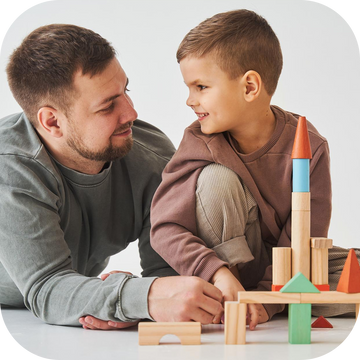Separation Anxiety: Helping Your Child Feel Safe & Secure
Picture this—you’re dropping your child off at school, giving them one last hug, and suddenly, their grip tightens, tears well up, and they refuse to let go.
Sound familiar?
Why Does Separation Anxiety Happen?
Children, like adults, fear the unknown. When apart, they may worry:
Will Mommy or Daddy come back?
What if something happens while they’re away?
What if I don’t know what to do without them?
Parents feel it too! But when we show confidence and reassurance, children learn that separations are temporary and safe.
Here are 5 simple ways to help your child feel more secure.

1. Practice Separation in Familiar Spaces
Before expecting your child to confidently wave goodbye at school, start practicing small separations at home.
- Begin with short separations in a safe space: “I’m going to the kitchen, I’ll be back in 5 minutes.”
- Give them something to keep them occupied.
- Stick to your word—return on time to build trust.
- Gradually increase the time apart—maybe step outside for a few minutes.
- Once they’re comfortable, try short separations at a grandparent’s house or a trusted friend’s home.
Why It Works: This helps children trust that you always come back, making bigger separations easier.

2. The Drop-Off Strategy: Keep It Happy!
Saying goodbye is hard for both of you, but here’s the secret—your child feeds off your emotions. If you’re nervous or guilty, they’ll sense it and feel even more anxious.
- Keep goodbyes short, warm, and positive: "You’re going to have so much fun! I can’t wait to hear all about it!"
- Create a special goodbye ritual—a fun handshake, a kiss on the palm (to hold all day), or a quick hug.
- Never sneak away—it makes kids more anxious for future separations.
Why It Works: A happy goodbye = a confident child. When you show trust, they feel safe.

3. Prepare Your Child with Excitement
Children fear what they don’t understand.
- Talk about all the fun things they’ll do: "Today, you’ll build towers, sing songs, and play with your friends!
- Share your own fun experiences: "When I was little, I loved playing with the building blocks at school!"
- If possible, visit the place together before the first drop-off to make it feel familiar.
Why It Works: When kids visualize a positive experience, they feel excited instead of scared.

4. Start Small with Playdates or Short Visits
Help your child get used to being away from you by introducing short, fun separations.
- Arrange playdates with trusted friends or cousins.
- Let them spend an hour at a family member’s house while you step out.
- Slowly increase the time apart while reinforcing, “See? Mommy/Daddy always comes back!”
Why It Works: Short wins build confidence! The more they practice, the easier goodbyes become.

5. Be Consistent & Use Relatable Time Frames
Uncertainty is scary, so always stick to your promises about when you’ll return.
- Instead of saying, “I’ll pick you up at 2 PM,” say, “I’ll be back right after lunch!”
- For longer separations, give a predictable sequence: “You’ll play, have snack time, and then I’ll be here!”
- Even if they cry, follow through—if you return early, it signals that separation is something to fear.
Why It Works: Consistency builds trust and security, making separations easier over time.
